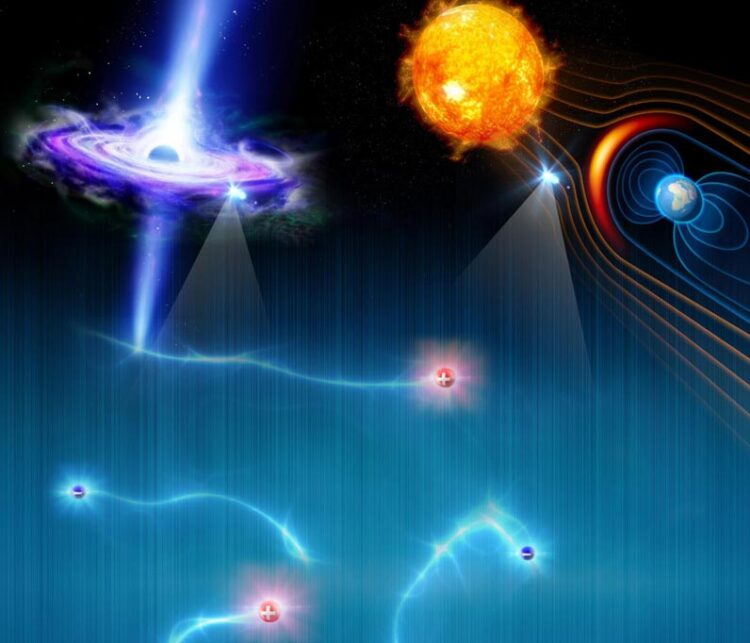Compressive fluctuations heat ions in space plasma

Artist's impression of the ions and electrons in various space plasmas.
Credit: Yohei Kawazura
New simulations carried out in part on the ATERUI II supercomputer in Japan have found that the reason ions exist at higher temperatures than electrons in space plasma is because they are better able to absorb energy from compressive turbulent fluctuations in the plasma. These finding have important implications for understanding observations of various astronomical objects such as the images of the accretion disk and shadow of the M87 supermassive black hole captured by the Event Horizon Telescope.
In addition to the normal three states of matter (solid, liquid, and gas) which we see around us every day, there is an additional state called plasma which exists only at high temperatures. Under these conditions, electrons become separated from their parent atoms leaving behind positively charged ions. In space plasma the electrons and ions rarely collide with each other, meaning that they can coexist in different conditions, such as at different temperatures. However, there is no obvious reason why they should have different temperatures unless some force affects them differently. So why ions are usually hotter than electrons in space plasma has long been a mystery.
One way to heat plasma is by turbulence. Chaotic fluctuations in turbulence smoothly mix with particles, and then their energy is converted into heat. To determine the roles of different types of fluctuations in plasma heating, an international team led by Yohei Kawazura at Tohoku University in Japan performed the world’s first simulations of space plasma including two types of fluctuations, transverse oscillations of magnetic field lines and longitudinal oscillations of pressure. They used nonlinear hybrid gyrokinetic simulations which are particularly good at modeling slow fluctuations. These simulations were conducted on several supercomputers, including ATERUI II at the National Astronomical Observatory of Japan.
The results showed that the longitudinal fluctuations like to mix with ions but leave electrons. On the other hand the transverse fluctuations can mix with both ions and electrons. “Surprisingly, the longitudinal fluctuations are picky about the partner species to mix with,” says Kawazura. This is a key result for understanding the ion to electron heating ratios in plasmas observed in space, like that around the supermassive black hole in Galaxy M87.
###
These results appeared as Y. Kawazura et al. “Ion versus Electron Heating in Compressively Driven Astrophysical Gyrokinetic Turbulence” in Physical Review X, on December 11, 2020.
All latest news from the category: Physics and Astronomy
This area deals with the fundamental laws and building blocks of nature and how they interact, the properties and the behavior of matter, and research into space and time and their structures.
innovations-report provides in-depth reports and articles on subjects such as astrophysics, laser technologies, nuclear, quantum, particle and solid-state physics, nanotechnologies, planetary research and findings (Mars, Venus) and developments related to the Hubble Telescope.
Newest articles

After 25 years, researchers uncover genetic cause of rare neurological disease
Some families call it a trial of faith. Others just call it a curse. The progressive neurological disease known as spinocerebellar ataxia 4 (SCA4) is a rare condition, but its…

Lower dose of mpox vaccine is safe
… and generates six-week antibody response equivalent to standard regimen. Study highlights need for defined markers of mpox immunity to inform public health use. A dose-sparing intradermal mpox vaccination regimen…

Efficient, sustainable and cost-effective hybrid energy storage system for modern power grids
EU project HyFlow: Over three years of research, the consortium of the EU project HyFlow has successfully developed a highly efficient, sustainable, and cost-effective hybrid energy storage system (HESS) that…





















